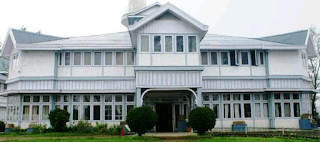Staying Archaeological for Christmas by Rakshanda Thakur
SA is all about understanding history in every possible way, which obviously includes a lot of museum tours and workshops. The tour to Shimla State Museum, though, was different : only three privileged members Vedant Chandel, Vidushi Chandel and I were a part of it, because we wanted to stay active for otherwise inactive weeks and work on regional archaeology.
Since all three of us hail from Shimla, we teamed up for the tasks ahead and thus The State Museum, Shimla was finalised as the place of our research. We walked all the way from Chotta Shimla to the Museum, a path that covered at least three of the major heritage walks of Shimla. It took us about an hour and to reach it, and although it was tiresome, we still had fun.
The State Museum Shimla is housed in a Victorian mansion, carefully altered to the requirements of a museum. It is built on the hilltop of ‘Inveram’ and is ,sometimes, known by this name, too. It belonged to General Innes in the 1860sl who also owned several other properties in Shimla. This, then became the property of Raja of Sirmaur, only to be later purchased by the Government. In the last quarter of the nineteenth century, the house was completely rebuilt of stone set in mud and was often allotted to the members of Viceroy’s Council. Its occupants included Lord William Beresford, the Military Secretary to the Viceroy Lord William Bentinck, who also contributed greatly to Shimla. When Lord William Beresford left India, the building was occupied by Sir Edwin Collan and thereafter, by Sir Edward Law, the Finance member of the Council. Later, it continued to serve as the residence of Indian Government officials.
This building was converted into the State Museum on January 26, 1974 to collect and preserve ancient artistic, historical, archaeological and ethnoarchaeological artefacts. The institution has played a significant role in collecting and preserving the scattered cultural heritage which otherwise, would have been completely lost to the ravages of time.
 |
| A few sculptures housed in the Shimla Museum |
We observed everything and as is a ritual, we called up Shriya in utter confusion, for her expert advice on the selection of topics. As instructed, we narrowed down the topics and went to the library inside the museum for more information on them.
The library was strikingly beautiful and seemed to be influenced by the Himachali culture as we had to get rid of our shoes and wear the traditional Himachali footwear. Unlike me and Vedant, who couldn’t stop chattering, Vidushi was more interested in actually going through the books!
We obviously got the pictures and all the information we could get about the topics and after an extravagant walk in and around the museum ,and a not-so-extravagant meal at the tiny canteen, we were done with the Shimla Museum, for the time being. The Museum would need a revisit-and soon!




Comments
Post a Comment